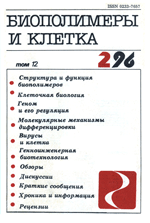Production of stress proteins in mechanism of forming of secondary radioresistance of rat cells of Geren carcinoma
DOI:
https://doi.org/10.7124/bc.000423Abstract
Influence of ionizing radiation at a dose of 8 Gy induces the expression of stress proteins (SP) 47,69/70, 80/82,107 and 140/150 kDa in rat cells of Geren carcinoma. T fie latter protein is not expressing under the other conditions. As far as forming of secondary acquired radioresistance (course of radiation 50 Gy alternated with innoculation) protein 140/150 is being detected not only after testing radiation but becomes constitutive.References
Blekhiman GI. Protein synthesis under stress. Usp Sovrem Biol. 1987. 103,(3): 340-53.
Baraboy VA, Gress VE. Stress proteins: the nature and biological role in mammals. Actual problems of medicine and biology. 1988. 2: 420-432.
Baraboy VA. Cellular stress, stress proteins and the stability of living systems. Actual problems of medicine and biology. 1993; 1: 12-8.
Nover L, Hellmund D, Neumann D. et al. The heat shock response of eukaryotic cells. Biol Zbl. 1984; 10(2):357-435.
Burdon RH. Heat shock and the heat shock proteins. Biochem J. 1986;240(2):313-24.
Burdon RH, Gill V, Evans CR. Active oxygen species and heat shock proteins. Stress proteins induction and function. Berlin: Springer, 1990: 19-25.
Black AR, Subjeck JR. Mechanisms of Stress-Induced Thermo- and Chemotolerances. Stress Proteins. Springer Berlin Heidelberg; 1990;101–17.
Hunt C, Morimoto RI. Conserved features of eukaryotic hsp70 genes revealed by comparison with the nucleotide sequence of human hsp70. Proc Natl Acad Sci U S A. 1985;82(19):6455-9.
Welch WJ, Suhan JP. Morphological study of the mammalian stress response: characterization of changes in cytoplasmic organelles, cytoskeleton, and nucleoli, and appearance of intranuclear actin filaments in rat fibroblasts after heat-shock treatment. J Cell Biol. 1985;101(4):1198-211.
Rose DW, Welch WJ, Kramer G, Hardesty B. Possible involvement of the 90-kDa heat shock protein in the regulation of protein synthesis. J Biol Chem. 1989;264(11):6239-44.
Lindquist S. The heat-shock response. Annu Rev Biochem. 1986;55:1151-91. Review.
Ananthan J, Goldberg AL, Voellmy R. Abnormal proteins serve as eukaryotic stress signals and trigger the activation of heat shock genes. Science. 1986;232(4749):522-4.
Li GC. Elevated levels of 70,000 dalton heat shock protein in transiently thermotolerant Chinese hamster fibroblasts and in their stable heat resistant variants. Int J Radiat Oncol Biol Phys. 1985;11(1):165-77.
Stress proteins in biology and medicine. Eds R. J. Marimoto, A. Tiesberes, G. Georgopuos. New York: Cold Spring Harbor Lab., 1991. 50 p.
Baraboy VA, Orel VE, Karnaukh YAM. Peroxidation and radiation. Kiev Naukova Dumka. 1991; 256 p.
Roll DE, Murphy BJ, Laderoute KR, Sutherland RM, Smith HC. Oxygen regulated 80 kDa protein and glucose regulated 78kDa protein are identical. Mol Cell Biochem. 1991;103(2):141-8.
Shibamoto Y, Sasai K, Abe M. The radiation response of SCCVII tumor cells in C3H/He mice varies with the irradiation conditions. Radiat Res. 1987;109(2):352-4.

